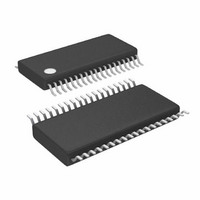LTC3855IFE#PBF Linear Technology, LTC3855IFE#PBF Datasheet - Page 18

LTC3855IFE#PBF
Manufacturer Part Number
LTC3855IFE#PBF
Description
IC CTLR DC/DC MULTIPHASE 38SSOP
Manufacturer
Linear Technology
Series
PolyPhase®r
Type
Step-Down (Buck)r
Datasheet
1.LTC3855EUJPBF.pdf
(44 pages)
Specifications of LTC3855IFE#PBF
Internal Switch(s)
No
Synchronous Rectifier
Yes
Number Of Outputs
2
Voltage - Output
0.6 ~ 3.3 V, 0.6 ~ 12.5 V
Current - Output
25A
Frequency - Switching
250kHz ~ 770kHz
Voltage - Input
4.5 ~ 38 V
Operating Temperature
-40°C ~ 125°C
Mounting Type
Surface Mount
Package / Case
38-TSSOP Exposed Pad, 38-eTSSOP, 38-HTSSOP
Lead Free Status / RoHS Status
Lead free / RoHS Compliant
Power - Output
-
Available stocks
Company
Part Number
Manufacturer
Quantity
Price
LTC3855
applicaTions inForMaTion
always the same and varies with temperature; consult the
manufacturers’ datasheets for detailed information.
Using the inductor ripple current value from the Inductor
Value Calculation section, the target sense resistor value is:
To ensure that the application will deliver full load current
over the full operating temperature range, choose the
minimum value for the Maximum Current Sense Threshold
(V
45mV, or 68mV, depending on the state of the I
Next, determine the DCR of the inductor. Where provided,
use the manufacturer’s maximum value, usually given at
20°C. Increase this value to account for the temperature
coefficient of resistance, which is approximately 0.4%/°C
or use LTC3855 DCR temperature compensation function.
A conservative value for T
To scale the maximum inductor DCR to the desired sense
resistor value, use the divider ratio:
C1 is usually selected to be in the range of 0.047µF to
0.47µF . This forces R1|| R2 to around 2kΩ, reducing error
that might have been caused by the SENSE pins’ ±1µA
current. T
The equivalent resistance R1|| R2 is scaled to the room
temperature inductance and maximum DCR:
The sense resistor values are:
The maximum power loss in R1 is related to duty cycle,
and will occur in continuous mode at the maximum input
voltage:
SENSE(MAX)
R
R
R1||R2 =
R1=
D
SENSE(EQUIV)
=
R1|| R2
DCR
L(MAX)
R
R
D
(DCR at 20°C) • C1
) in the Electrical Characteristics table (25mV,
(MAX)
SENSE(EQUIV)
; R2 =
is the maximum inductor temperature.
=
at T
I
V
(MAX)
SENSE(MAX)
L
L(MAX)
R1 • R
1− R
L(MAX)
+
∆I
2
D
L
D
is 100°C.
LIM
pin).
Ensure that R1 has a power rating higher than this value.
If high efficiency is necessary at light loads, consider this
power loss when deciding whether to use DCR sensing or
sense resistors. Light load power loss can be modestly
higher with a DCR network than with a sense resistor, due
to the extra switching losses incurred through R1. However,
DCR sensing eliminates a sense resistor, reduces conduc-
tion losses and provides higher efficiency at heavy loads.
Peak efficiency is about the same with either method.
To maintain a good signal to noise ratio for the current
sense signal, use a minimum ∆V
cycles less than 40%. For a DCR sensing application, the
actual ripple voltage will be determined by the equation:
NTC Compensated DCR Sensing
For DCR sensing applications where a more accurate
current limit is required, a network consisting of an NTC
thermistor placed from the ITEMP pin to ground will
provide correction of the current limit over temperature.
Figure 2b shows this network. Resistors R
linearize the impedance the ITEMP pin sees. To implement
NTC compensated DCR sensing, design the DCR sense
filter network per the same procedure mentioned in the
previous selection, except calculate the divider components
using the room temperature value of the DCR. For a single
output rail operating from one phase:
1. Set the ITEMP pin resistance to 50k at 25°C. With
2. Calculate the ITEMP pin resistance and the maximum
10µA flowing out of the ITEMP pin, the voltage on the
ITEMP pin will be 0.5V at room temperature. Current
limit correction will occur for inductor temperatures
greater than 25°C.
inductor temperature which is typically 100°C. Use the
following equations:
P
∆
LOSS
V
SENSE
R1=
=
(
V
V
IN
R C
IN(MAX)
1 1
−
•
V
OUT
− V
R1
V
IN
OUT
V
OUT
•
f
OSC
)
SENSE
• V
OUT
of 10mV for duty
S
and R
P
will
3855f













